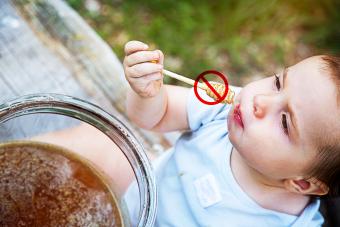
Wanting to end the breastfeeding relationship may be due to the mother or the child, but knowing how to stop breastfeeding appropriately in both situations is important.
Ending Breastfeeding
The benefits of breastfeeding to both mom and baby's physical and emotional needs are undeniable. However, there may come a time when one or both partners in the relationship feel the need to end breastfeeding.
Mothers may feel the need if they have had multiple infections or problems with breastfeeding. Certain prescription medications might infiltrate mother's milk, so a woman may need to stop breastfeeding at this time. Women who want to have another child and are experiencing lactational amenorrhea might be able to conceive while breastfeeding, but chances of conception will be lower due to menstruation changes while breastfeeding.
Children can sometimes indicate they are ready to end breastfeeding. As solids and other forms of foods are introduced, their need to nurse for nutritional purposes decreases. It is important not to confuse a nursing strike in an infant with child-led weaning that usually occurs in breastfeeding toddlers.
How to Stop Breastfeeding Infants and Toddlers
Whenever you decide that breastfeeding is no longer beneficial to both you and your baby, it is time to figure out how to stop breastfeeding. The process can be an emotional one for you, so be prepared to have conflicting feelings as you look to the end of your breastfeeding relationship.
Stopping breastfeeding requires similar tactics to help mothers deal with the physical issues of lactating, regardless of age, but the way you handle breastfeeding weaning with infants versus toddlers will be different.
Stopping Infant Breastfeeding
An infant nurses frequently during both day and night, anywhere from 8 to 12 times in a 24 hour period. Follow these steps to stop breastfeeding an infant:
- Cut out one breastfeeding session a day, offering formula/frozen breastmilk or introducing solids at this time.
- Allow several days for your body to adjust to the loss of the breastfeeding session.
- Replace another feeding time with formula or solids.
- Wait several days for your body to adjust to the new schedule.
- Repeat this process until you have completely weaned the baby from your breast.
The total amount of time this takes can range anywhere from one to two months, depending on how quickly your body and emotions adjust. Your baby may need a bit of adjustment time, also, especially if he is being switched from breast to bottle. Try to find a bottle with naturally shaped nipples to help make the transition go smoothly and always hold your baby while giving him a bottle.
Stopping Toddler Breastfeeding
A toddler will nurse much less frequently than a baby. Between 18 and 24 months, most children are eating table foods at least three times a day, plus snacks. Breastfeeding may occur at night or before naps; comfort and boredom breastfeeding is fairly common, too.
Because the child is older, it can be easier to wean him. You should offer a snack or milk in a sippy cup when your child is hungry. Avoid breastfeeding triggers. Instead, occupy him with an activity or game. Introducing a comforting stuffed animal can help calm him before naps and bedtime instead of nursing.
Toddlers may themselves want to stop breastfeeding. This idea is called baby-led weaning or child-led weaning. It involves continuing the relationship until the child himself decides he no longer needs to breastfeed.
If your child has nutritional deficiencies, was a preemie or has other physical or emotional issues, your doctor may recommend nursing for a longer period of time. All concerns regarding stopping breastfeeding of a child at any age should be brought to the attention of your healthcare provider.
Avoid Weaning Complications
Sudden weaning or going "cold turkey" is not recommended, unless medically necessary, for women who have been breastfeeding. Not only can this cause confusion to the child, but it can lead to physical problems for the mother.
Engorgement is one complication common to weaning. You may be tempted to pump all of your milk, but that will only cause your body to produce more. Instead, express just a little amount in order to relieve pain.
Plugged milk ducts are another frequent problem with stopping breastfeeding. A plugged duct will feel like a hard lump in the breast. You must rid the body of the plug to lower the risk of developing an infection called mastitis.
Tips to avoid complications from stopping breastfeeding include:
- Wear a firm fitting bra (not underwire) during the weaning process.
- Cool or cold compresses on top of the breasts or inside the bra will also help relieve pain and engorgement.
- Avoid taking hot showers, and stand with your back to the water.
- Talk to your doctor about how to stop breastfeeding in a way that will keep you healthy and pain-free.







